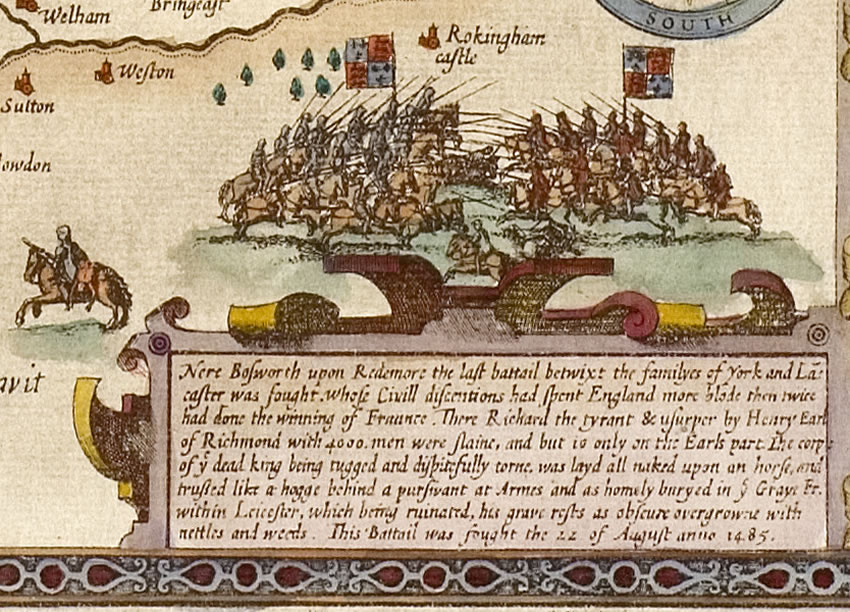Fighting Bosworth
Chapter 3 : Private Feuds
Northumberland’s deliberate inaction at Bosworth highlights the need to view the battle through the eyes of its participants, not merely through the actions of Richard and Henry alone. With battle came the legitimate opportunity to settle old scores; it was on the field that private and public grievances could be settled as one. The Stanley feud with the Harringtons is a well known example; it provided an opportunity for Stanley to ensure that his local rival was all but destroyed for taking Richard’s side, leaving him with ‘ no livelihood’ and in ‘great poverty’ as a result of his attainder after the battle, which Sir James Harrington’s nephew later claimed ‘was laboured to be made by Thomas late earl of Derby, for old malice and grudge that he had ’. Richard Beaumont went so far as to declare that Thomas Stanley had ‘caused’ Sir James Harrington to be attainted, ‘where in for a truth the said James was never against the King in no field’.[1]
The Stanley-Harrington feud was not the only one amongst those fighting that day. One north Midlands squire, John Babington of Dethick, was allegedly killed by James Blount, motivated by the chance to increase his inheritance. But Blount got the wrong man. His intended target had been John Babington of Chilwell. Other men had personal grievances against the Yorkists. William Troutebeck, whose family had possession of Oxley manor in Hertfordshire, had his lands confiscated by Edward IV who, according to a petition lodged by Troutebeck, had ordered its woods to be cut down and sold as timber. Troutebeck, on hearing of Henry’s landing, ‘ came unto your most honourable service, at your last most victorious field’.[2] Reynold Hassalle was rewarded for his ‘good and trusty service, specially at our victorious journey’ with the restoration of his office of bailiff of Grene, near Stafford, which he had occupied through the gift of the Duke of Buckingham, but which Richard had apparently ‘put him out of the same’.[3]
Other grudges fought out that day were more long-standing. Robert Harcourt was the son of John Harcourt, a rebel in Buckingham’s revolt who had died at Henry’s exiled ‘court’ on 26 June 1484. His father’s lands had been confiscated upon his attainder, being granted to Richard’s supporters, including Viscount Lovell. [4] John Harcourt ‘went over the seas’ to Henry. His motivation to turn against Richard seems to have stemmed from the king’s support for the Staffords of Grafton, a family with a longstanding hostility to the Harcourts. The feud between the families had begun in 1448 when John Harcourt’s father, Sir Robert, a veteran of the French wars, was involved in a fight with Sir Humphrey Stafford, in which Stafford was struck on the head with a sword and Harcourt was stabbed in the back and pulled off his horse by one of Stafford’s retainers.
The case never came to trial, but five years later Sir Humphrey retaliated by besieging his property at Stanton Harcourt, where Sir Robert took refuge in the nearby church tower and withstood a siege of six hours. Twenty years later, however, the feud flared up again when Sir Robert was killed by Sir Humphrey’s bastard son and 150 retainers. John clearly did not forget his father’s death when the Staffords came to prominence in Richard’s reign, and were serve him holding the fords of the Severn against Buckingham. In the end, it was to be his son who would seek to avenge the family name on the battlefield, supposedly at some stage becoming Henry’s standard bearer at Bosworth, presumably after William Brandon’s death.

The final scene of the battle, around the scramble for the fallen Tudor standard, the brave last stand of Sir Percival Thrivall, who held onto Richard’s standard, despite having both legs cut from under him, has become the stuff of legend, at times testament to Richard’s own bravery and strength. In the eighteenth century, the antiquarian John Nichols recalled speaking with a lady who had read a manuscript account of the battle which had subsequently been destroyed, which stated that Richard had cleaved William Brandon ‘ down the head at one blow’.[5]
Of course stories such as this, told long after the battle itself, provide little evidence of such events occurring, however they cannot be entirely discounted. In 1610, James Ley, claimed that his great-grandfather, Henry Ley, had been ‘a man of arms’ on Henry’s side, ‘ and was near about the earl’s person, at such time the king was slain by one Thomas Woodshawe ’.[6] Yet we know that Henry Ley accompanied his lord Sir Robert Willoughby to the battle, and that a Thomas Woodshawe, a tenant on the Middleton Hall estate also owned by the Willoughby family, was rewarded on 20 September with the office of bailiff of the lordship of Berkeswell in Warwickshire and made keeper of the park there ‘during pleasure’. [7]
According to Welsh tradition, it was Rhys ap Maredudd, known also as Rhys Fawr, ‘Rhys the Mighty’ who had immediately picked up the Red Dragon banner; the same tradition also states that it was the same Rhys who killed Richard, though another poet, Tudur Penllyn, gifts that honour to Rhys ap Thomas.
Rhys ap Thomas was rewarded for his decision to support Henry; indeed, he was granted the office of Chamberlain of South Wales which he had so coveted. Many of Henry’s Welsh troops were also rewarded. Adam ap Jevan ap Jankyn was made the king’s attorney within Carmarthen and Cardigan, ‘ in consideration of the true service that our well beloved subject hath done unto our noble progenitors of long time passed, and to us now late in our victorious journey and field, to his great costs and damages ’.[8] Through the grants, which have inexplicably been little explored, we can obtain a fuller picture of those who fought at Bosworth, and who had made the long journey with Henry from exile.
[1] Bodleian Library MS Add d. 113 fo.28.
[2] Materials I pp.140-41.
[3] Materials I p.202.
[4] CPR 1476-85 p.498.
[5] Nichols, p.136.
[6] Wiltshire Record Office Ref 366/1 p.10, cited Ricardian, Vol IX no.121 pp.417-25.
[7] CPR 1485-94 p.4, 289; R. Skinner, ‘Thomas Woodshawe, ‘Grasiour’ and Regicide’ Ricardian Vol IX no 121 pp.417-25.
[8] Materials I p.164-5.






